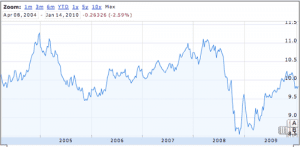Currency Considerations

When importing from China almost all suppliers list their prices in US Dollars and want to be paid in US Dollars. You will almost never find a supplier who lists their prices in the local Chinese currency, RMB. The reason behind this (and for the Finance people this will almost certainly open up a huge debate!) is that China essentially pegs their currency to the US Dollar (although not officially for several years).
This isn't exactly unheard of in international trade, but it's a point worth considering.
If you're an American this makes importing from China relatively risk free, at least in terms of currency risk. Presumably you get paid in US Dollars and therefore you can pay your Chinese suppliers in US Dollars. If you're non-American but your main revenue is in US Dollars (as is my company and countless others) this also makes currency risk a non-issue. Long story short, if you're going to price your goods in US dollars, your life is a lot easier because you'll never have to take currency fluctuation into account.
For the rest of you, currency is a real pain. Take for example the chart below showing what happened to the the Euro:RMB conversion rate during the financial crisis.

If you imported anything in late 2008 and paid with Euros you would have paid nearly 20% more. Ouch! Talking with some of my suppliers, many of them had long term European customers go bust. Currency devaluation wasn't the only reason, but it was a contributing factor.
So as an international importer, beware! Receiving a shipment of MP3 players from your supplier that disintegrate after a week isn't your only concern. So is currency!
Currency exchange risks are always a serious consideration in international trade.
http://blogs.wsj.com/chinarealtime/2014/01/08/is-china-about-to-let-the-yuan-rise-dont-hold-your-breath/?mod=WSJBlog&utm_medium=social&utm_source=linkedin.com&utm_campaign=buffer&utm_content=bufferb1a45



